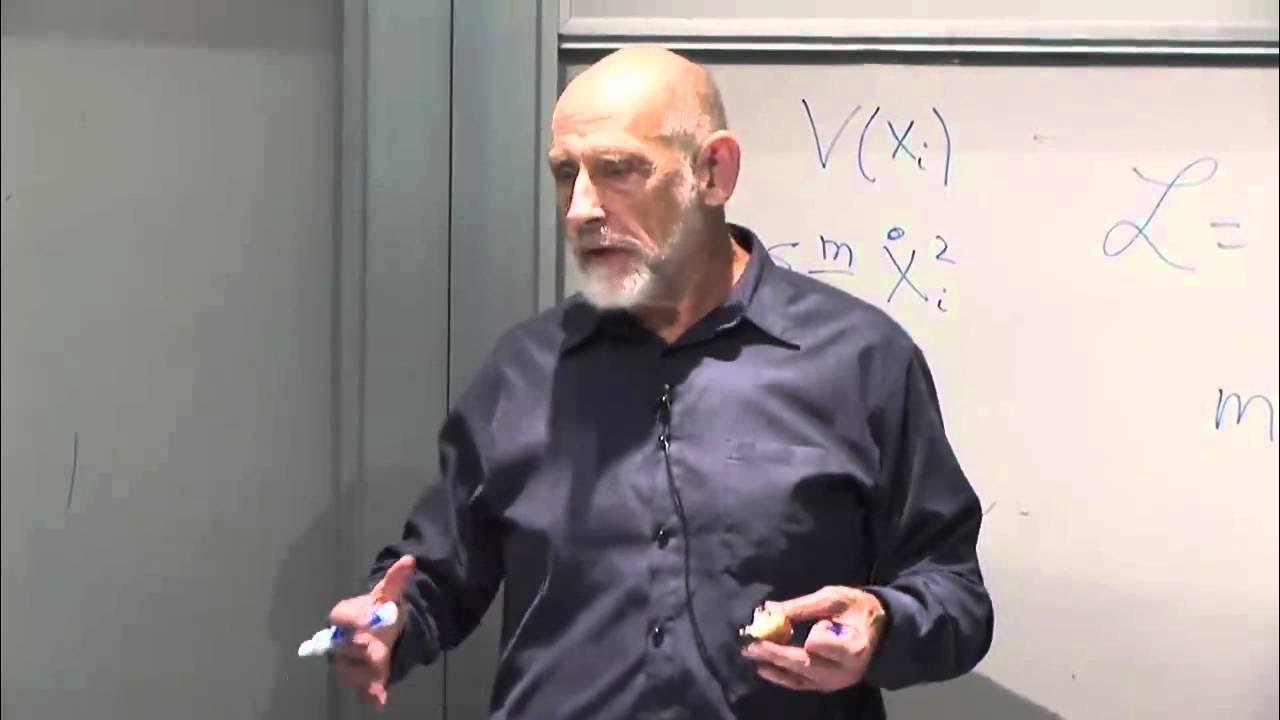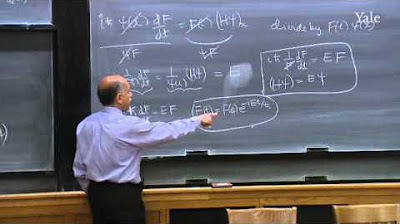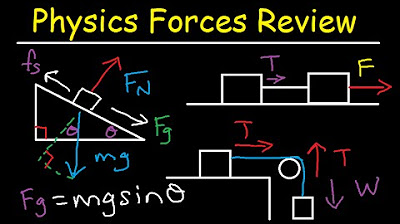Classical Mechanics | Lecture 1
TLDRThis transcript delves into the fundamentals of classical mechanics, focusing on the laws of motion and their application to various systems. It begins with simple examples like coins and dice to illustrate the concept of dynamical systems and the predictability of physical laws. The discussion then transitions to more complex systems, such as particles in motion, emphasizing the importance of initial conditions and the deterministic nature of classical mechanics. The use of vectors and coordinate systems to describe particle positions and velocities is detailed, along with the mathematical concepts of velocity and acceleration. The transcript also explores the idea of reversibility in physical laws and the limitations of predictability in real-world scenarios due to the chaotic nature of systems like the atmosphere. The examples of linear motion and circular motion serve to demonstrate how these principles apply in practice, rounding out a comprehensive introduction to classical mechanics.
Takeaways
- 📜 Classical mechanics involves a set of rules, primarily focusing on two types of questions: specific laws for particular systems and the grand framework in which all specific laws are framed.
- 🪙 The simplest dynamical system example is a coin with two states (heads or tails), illustrating that the laws of motion can be as straightforward as no change over time.
- 🔄 A more complex example is a die with six states, where possible laws of motion can range from no change to cyclical changes, demonstrating deterministic behavior.
- 🔢 In classical mechanics, the predictability of a system's future is based on its initial conditions and the laws of motion, which must be known to forecast its behavior.
- 🔄 The concept of a cycle in motion is introduced, where a system can be trapped in a specific cycle or state, leading to the idea of conserved quantities that do not change over time.
- 📐 The introduction of coordinate systems and vectors is essential for describing the position and motion of particles in space, with Cartesian coordinates being a common method.
- 📐 Vectors are mathematical objects with both magnitude and direction, and their algebra includes addition, subtraction, and multiplication by numbers, but not division.
- 🤔 The script discusses the importance of determinism and reversibility in classical physics, where laws of motion allow for prediction of both future and past states of a system.
- 🌀 The example of circular motion helps to illustrate key concepts such as velocity and acceleration, showing that velocity is perpendicular to the position vector and acceleration points towards the center of the circle.
- 📚 The script emphasizes the foundational aspects of classical mechanics, setting the stage for further exploration into the initial conditions, configuration space, and the laws that govern particle motion.
Q & A
What are the two types of questions discussed in the context of classical mechanics?
-The two types of questions are: 1) specific laws for particular kinds of systems, such as a planet moving in the field of a heavy mass or an electrically charged particle moving in a magnetic field, and 2) the general framework or grand framework in which all the various specific laws of physics are framed.
What is the significance of the coin illustration in the lecture?
-The coin illustration is used to demonstrate a simple dynamical system with two states (heads or tails). It helps to explain the concept of initial conditions and the idea of laws of motion, showing how the state of the system can be predicted over time based on these laws.
How does the law of motion for the coin system work?
-The law of motion for the coin system is that it stays the same over time. If the coin starts on heads, it remains heads indefinitely, and the same goes for tails. This law is deterministic, meaning the future state of the system can be precisely predicted from its current state.
What is the concept of a conserved quantity in physics?
-A conserved quantity is a non-trivial property that remains constant over time in a system. In the context of the die example, the concept is illustrated by the cycles of states that a die can follow, which can be labeled with different values. If the die starts with a certain value, it will continue to follow the cycle associated with that value, thus conserving it over time.
How does classical mechanics differ from non-deterministic systems?
-Classical mechanics is characterized by deterministic laws of motion, meaning that the future and past states of a system can be precisely predicted from its current state and the laws of motion. Non-deterministic systems, on the other hand, do not allow for such precise predictions and may involve elements of chance or probability.
What is the role of initial conditions in predicting the future behavior of a system?
-Initial conditions are crucial for predicting the future behavior of a system. In classical mechanics, if the initial conditions and the laws of motion are known, the future and past states of the system can be determined with certainty. However, in real-world scenarios, perfect knowledge of initial conditions is often unattainable due to the complexity and continuous nature of the systems, leading to limitations in predictability.
How is a vector defined and what are its components?
-A vector is defined as an object that has both length (magnitude) and direction. Its components are the quantities that represent the vector's length along each axis in a coordinate system. In three-dimensional space, these are typically the x, y, and z components, which can be positive or negative depending on the direction relative to the coordinate axes.
What is the dot product of two vectors and how is it related to the angle between them?
-The dot product of two vectors is a scalar quantity obtained by multiplying the magnitude of one vector by the component of the other vector along the first vector's direction, and then by the cosine of the angle between the two vectors. The dot product is positive if the angle is less than 90 degrees, zero if the vectors are perpendicular (angle is exactly 90 degrees), and negative if the angle is greater than 90 degrees.
How can you determine if two vectors are perpendicular?
-You can determine if two vectors are perpendicular by calculating their dot product. If the dot product is zero, the vectors are perpendicular to each other.
What is the relationship between position, velocity, and acceleration in classical mechanics?
-In classical mechanics, the position of a particle is described by a vector that depends on time. The velocity of the particle is the first time derivative of the position vector, giving the speed and direction of the particle at any instant. The acceleration is the second time derivative of the position vector, indicating how the velocity changes over time, including its rate and direction of change.
What is the significance of circular motion in understanding classical mechanics?
-Circular motion is significant in understanding classical mechanics because it provides examples of vectors and their derivatives in action. It illustrates how the position, velocity, and acceleration vectors are related in a moving system, such as the perpendicularity of velocity and position, and the centripetal acceleration directed towards the center of the circle.
Outlines
📚 Introduction to Classical Mechanics
The paragraph introduces classical mechanics as a set of rules governing motion, specifically focusing on two types of questions: the specific laws for particular systems and the general framework for allowable laws. It uses the analogy of a coin with two states (heads or tails) to illustrate a simple dynamical system and its laws of motion, emphasizing the predictive power of these laws.
🔄 Laws of Motion for Simple Systems
This paragraph delves into the laws of motion for simple systems like a coin and a die, exploring different possible laws and their implications. It introduces the concept of a configuration space and the idea of a completely predictive and deterministic system. The paragraph also discusses the mathematical representation of these laws and the concept of conservation laws in the context of simple dynamical systems.
🎲 Evolution of States in Dynamical Systems
The paragraph discusses the evolution of states in dynamical systems, using the example of a die to illustrate different possible laws of physics. It introduces the concept of cycles and the idea of logically equivalent laws, highlighting the deterministic nature of these systems. The discussion also touches on the concept of conserved quantities and their role in distinguishing different types of evolutions within the system.
🔄 Complex Evolution and Conservation in Dynamical Systems
This paragraph continues the exploration of dynamical systems, introducing more complex evolutions with multiple cycles and the concept of conserved quantities. It explains how different initial conditions can lead to different cycles and how these cycles are indicative of the system's behavior. The paragraph also hints at the idea of non-reversible laws and their implications in classical physics.
🚫 Non-Allowable Laws in Classical Mechanics
The paragraph discusses non-allowable laws in classical mechanics, using the example of a three-sided coin to illustrate a law that is predictive of the future but not reversible to the past. It emphasizes the importance of reversibility in classical physics and the concept of initial conditions in determining the predictability of a system. The discussion also briefly touches on the concept of probability and its incompatibility with classical mechanics.
📈 Predictability and Limits in Classical Mechanics
This paragraph explores the limits of predictability in classical mechanics, emphasizing the need for exact knowledge of initial conditions and the laws governing the system for perfect predictability. It discusses the concept of chaos and the inherent uncertainty in real-world systems due to the continuous nature of degrees of freedom. The paragraph also touches on the idea of predictability in the context of classical statistical mechanics.
📐 Coordinate Systems and Vectors in Physics
The paragraph introduces the concept of coordinate systems and vectors as a way to quantitatively describe the location of particles in space. It explains the use of Cartesian coordinates, the right-handed coordinate system, and the importance of choosing units. The paragraph also defines vectors, their magnitude and direction, and discusses the algebra of vectors, including addition, subtraction, and scalar multiplication.
📐 Further Discussion on Vectors
This paragraph continues the discussion on vectors, focusing on the algebraic operations involving vectors such as addition, subtraction, and scalar multiplication. It introduces the concept of the dot product, explaining its geometric interpretation and how it can be used to calculate the angle between two vectors. The paragraph also presents the law of cosines and its application in calculating the length of the third side of a triangle formed by two vectors.
🌟 Position, Velocity, and Acceleration of Particles
The paragraph discusses the concepts of position, velocity, and acceleration in the context of particle motion. It defines position as a vector from the origin to the particle, velocity as the time derivative of position, and acceleration as the time derivative of velocity. The paragraph uses examples of motion along a line and circular motion to illustrate these concepts and their mathematical representations, highlighting the importance of these quantities in describing the motion of particles.
🔄 Circular Motion and Vector Analysis
This paragraph focuses on the analysis of circular motion, detailing the mathematical representation of a particle's position, velocity, and acceleration in such motion. It explains how to calculate the angular frequency and period of the motion, and uses vector analysis to demonstrate that the velocity and position are perpendicular and that the acceleration is directed towards the center of the circle. The discussion also includes the calculation of the magnitude of velocity and acceleration in terms of angular frequency.
Mindmap
Keywords
💡Classical Mechanics
💡Laws of Motion
💡Dynamical System
💡Initial Conditions
💡Deterministic
💡Conserved Quantity
💡Coordinate System
💡Vector
💡Dot Product
💡Acceleration
Highlights
Stanford University classical mechanics lecture introduces the concept of rules governing motion.
Two varieties of questions are discussed: specific laws for particular systems and the grand framework for allowable laws.
A simple coin system with two states (heads or tails) is used as an illustration of dynamical systems.
The law of motion for the coin system is explored, showing a deterministic approach to physics.
The concept of initial conditions is introduced as the starting point for predicting the future state of a system.
The die system with six states is presented as a more complex example of a dynamical system.
Conservation laws and conserved quantities are discussed in the context of the die system and its different possible laws of motion.
The concept of reversibility in classical physics is explained, where knowing the initial conditions allows for perfect prediction of both future and past.
The non-allowable law of motion for a three-sided coin is introduced to illustrate non-reversible systems.
The importance of knowing initial conditions for predictability in classical mechanics is emphasized.
The lecture transitions to discussing the world of particles, introducing the concept of point particles moving in space.
Coordinate systems and vectors are introduced as fundamental tools for describing the motion of particles.
The algebra of vectors, including addition, subtraction, and scalar multiplication, is discussed.
The dot product of vectors is defined and its properties are explored, including how it can be used to determine the angle between two vectors.
The law of cosines is derived using the dot product, relating the sides and angles of a triangle formed by vectors.
The position, velocity, and acceleration of a particle are described as functions of time, with examples of motion along a line and circular motion.
The relationship between velocity and position vectors in circular motion is highlighted, showing they are perpendicular.
The mathematics behind centripetal acceleration in circular motion is presented, demonstrating its direction towards the origin.
The magnitude of velocity and acceleration in circular motion is related to the angular frequency, with acceleration being proportional to the square of the angular frequency.
Transcripts
Browse More Related Video

Symmetries & Conservation Laws: A (Physics) Love Story

Differential Equations with Velocity and Acceleration (Differential Equations 7)

Classical Mechanics | Lecture 3

24. Quantum Mechanics VI: Time-dependent Schrödinger Equation

Static & Kinetic Friction, Tension, Normal Force, Inclined Plane & Pulley System Problems - Physics

Chaos Theory: the language of (in)stability
5.0 / 5 (0 votes)
Thanks for rating: